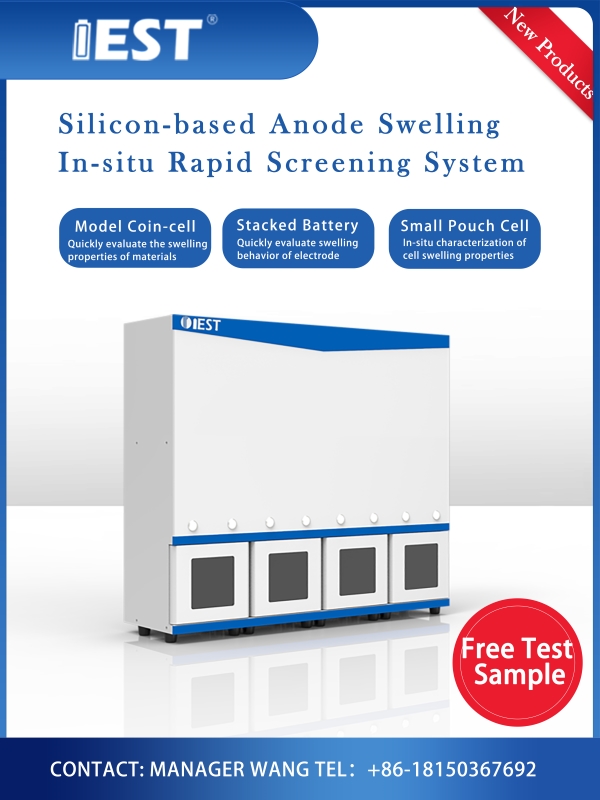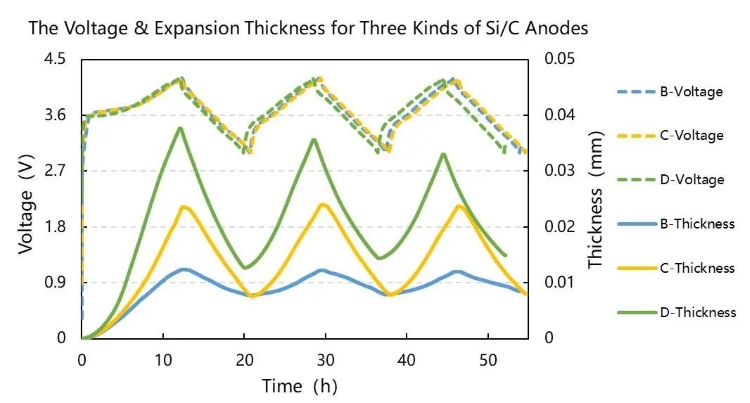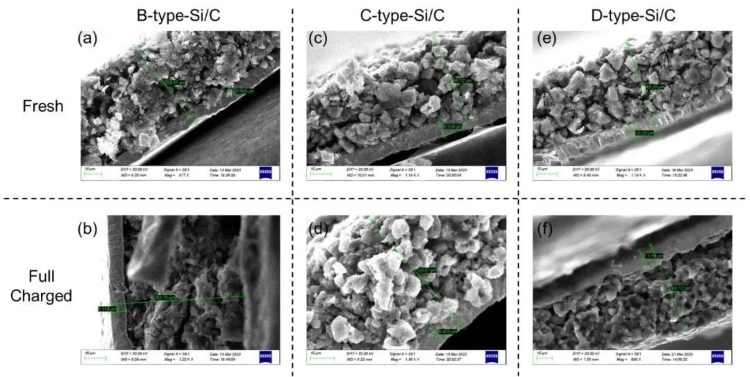Silicon Anode Swelling Can Be Quickly Evaluated Without the Need for Battery Fabrication
Silicon (Si) negative electrode material, with its unique advantages of high theoretical capacity (4200mAh/g) and abundant resources, is expected to replace widely used graphite negative electrodes and become the main negative electrode material for the next generation of lithium-ion batteries. The most promising silicon-based anodes for large-scale commercialization are silicon-carbon anodes and silicon-oxygen anodes, both of which have high specific capacities. However, due to the alloying and de-alloying mechanism of silicon, the significant structural swelling caused by it can damage the pre-existing solid electrolyte interface (SEI) on the surface of the silicon material. This leads to the continuous destruction and regeneration of the SEI film during cycling, consuming a large amount of electrolyte, and ultimately resulting in rapid decay of battery capacity. ² Therefore, evaluating the performance of a silicon material, aparts from the specific capacity, initial efficiency, and cycle efficiency, the evaluation of its swelling performance is also crucial.
The existing methods for evaluating swelling performance require the silicon negative electrode material to be prepared into a pouch cell or stacked cell, and then monitored for in-situ swelling using force structures and high-precision sensors (such as IEST's SWE swelling series). However, the preparation process from powder material to finished cell not only requires a mature cell production line but also has a long evaluation cycle. Therefore, how to quickly evaluate the swelling performance of a silicon material has become a difficult problem for many material researchers.
IEST has recently developed a four-channel in-situ rapid screening system for silicon-based negative electrode (as shown in Figure 1). Learned from the assembly mode of the coin cell battery, it has successfully achieved direct measurement of the swelling performance of silicon negative electrodes at the electrode end. This system eliminates the manpower, material, and time costs required for preparing finished battery cells and accurately evaluates the most important performance indicators of silicon negative electrode materials with minimal consumption and maximum efficiency, allowing you to stay ahead in research and development. In addition, this device is also compatible with conventional swelling testing of small-sized pouch cell and stacked battery cells (100*100mm), truly achieving multi-purpose use.

Figure 1. Silicon-based anode swelling in-situ fast screening system (four channels)
1.Swelling Test of Different Silicon Carbon Materials
1.1 Test Sample Information
Positive Electrode: NCM811, is cut into diameter 14mm disc shape.
Negative Electrode: B, C, and D have similar capacities (~5.9mAh), but different modification methods,are cut into 16mm diameter discs shape (the B material is specially modified by a battery material company in Ningbo low-expansion silicon-carbon material, while C and D are two common silicon-carbon materials on the market).
Electrolyte: commercial electrolyte.
Separator: PP separator, is cut into 18mm diameter discs shape.
1.2 Test Information and Process
Table 1. Charge and Discharge Process
No. | Test Steps | Cut-off Conditions | Electric Current |
1 | Resting | 10h | \ |
2 | Constant current charge | 4.2V | 0.48mA |
3 | Resting | 10 min | \ |
4 | Constant current discharge | 3V | 0.48mA |
5 | Resting | 10 min | \ |
6 | Cycle | Skip to No.2 | 3 circles |
1.3 Analysis of Swelling Results
In the glove box, three silicon-carbon materials were assembled into a coin-cell full battery (the positive electrode uses the same NCM material to ensure the principle of single variable), and the rapid swelling test was performed using the silicon-based negative electrode expansion in-situ fast screening system of IEST Technology, and the result is shown in Figure 2. First of all, the three silicon-carbon materials all expand with charging and shrink with discharge, which is consistent with the swelling of lithium ion intercalation when the negative electrode is charged, and the shrinkage of lithium ion deintercalation during discharge. Therefore, although we assembled a full battery, the overall swelling behavior of the battery is still dominated by the negative electrode, while the swelling and contraction of the positive electrode is much smaller than that of the negative electrode³. Secondly, the inflection points of the swelling curves of the three are also highly consistent with the inflection points of the charge and discharge curves, indicating that the swelling curves can reflect the expansion and contraction behavior during the lithium-ion battery deintercalation process.
At the same time, the model coin cell swelling evaluation method can also effectively evaluate the swelling difference between different silicon-carbon materials. It can be clearly seen from Figure 2 that in the same operating voltage range, the overall swelling of the B-type silicon-carbon material is much smaller than that of the other two types of silicon-carbon materials, indicating that the special modification treatment can greatly inhibit the growth of the silicon-carbon negative electrode. Swelling, thereby reducing a series of side reactions caused by swelling, and ultimately improving the cycle performance of the material. In addition, Table 2 and Table 3 respectively count the swelling thickness and swelling rate data of the three silicon-carbon materials, from which it can be seen that: (1) The expansion of the three silicon-carbon materials for the first charge will be higher than that of the first discharge and the last two cycles The swelling of charge and discharge is much larger, and there is a certain irreversible swelling in the first cycle of charge and discharge. This is because the negative electrode will generate SEI film and produce certain irreversible swelling on the surface of active particles in addition to lithium intercalation swelling during the first charge. (2) Comparing the swelling data of the last two cycles of charging and discharging, it can be seen that the average swelling thickness of the B-type silicon-carbon material after modification is only ~4.2μm, and the swelling rate is ~8.9%, while the C-type material and D The average swelling of the type B material is 3.7 times and 5 times that of the B type material, respectively that the swelling modification effect of the B type material is very obvious.

Figure 2.Using the model battery to quickly evaluate the swelling thickness change of three different silicon-carbon materials during 3 cycles of charge and discharge, where the dotted line is the voltage versus time curve, and the solid line is the swelling thickness change curve with time.
Table 2.The swelling thickness of three silicon carbon materials per charge and discharge cycle

Table 3. Swelling rate of three silicon carbon materials per charge and discharge cycle

2.Electron Microscope Observation of Different Sic Materials
In addition, in order to compare the swelling of the pole piece measured by the model button with the result of manual thickness measurement, we disassembled the fully filled silicon carbon pole piece, and observed and compared the cross-section of the pole piece under the scanning electron microscope. The thickness was measured and the results are shown in Figure 3. After deducting the thickness of the copper foil, the coating thickness of the Type B silicon carbon pole piece expands from ~50.81 μm to ~55.45 μm after being fully charged, and the total swelling is ~4.64 μm, which is the same as the average swelling thickness measured by using the model buckle. very close. In addition, for the C and D silicon-carbon materials, the coating thickness expanded by ~11.98 μm and ~14.65 μm respectively after full filling, which is like the swelling data of the last two cycles in Table 2. To sum up, no matter whether the model is used for in-situ monitoring, or the pole piece is disassembled for electron microscope observation, the swelling trends of the three silicon-carbon materials are consistent, that is, D>C>B.

Figure 3. Scanning electron microscope images of the cross-sections of three silicon carbon pole pieces before being fully charged (Fresh) and after being fully charged (Full Charged). Among them, (a-b) is the electron microscope image of type B silicon-carbon material; (c-d) is the electron microscope image of type C silicon-carbon material; (e-f) is the electron microscope image of type D silicon-carbon material.
3.Summary
In this paper, the rapid expansion test of three silicon-carbon materials with different modification conditions was carried out by using the IEST silicon-based negative electrode swelling in-situ fast screening system. The three-silicon carbon negative electrodes do not need to be prepared into soft packs or laminated cells, but only need to be assembled into a model button battery to directly test the swelling thickness of the silicon carbon negative electrode sheet in situ, which not only saves the preparation of finished cells. The cumbersome steps also greatly improve the efficiency of the swelling evaluation of silicon-based materials. It can be seen from the in-situ test results of the model buckle, the swelling of the B-type silicon-carbon material after special modification is much smaller than the C and D-type silicon-carbon materials that are common on the market. At the same time, we also disassembled the fully charged pole piece and observed it with an electron microscope. The observation results showed the same trend as the in-situ test of the model buckle, that is, the swelling of the B-type silicon-carbon material was the smallest among the three, indicating that IEST The silicon-based negative electrode swelling in-situ fast screening system can directly evaluate the swelling performance of the material at the electrode end, accurately evaluate the most important performance indicators of the silicon negative electrode with the smallest consumption and the fastest efficiency, and make your research and development one step faster!
4.Reference Materials
[1] M. Ashuri, Q.R. He and L.L. Shaw, Silicon as a potential anode material for Li-ion batteries: where size, geometry, and structure matter. Nanoscale 8 (2016) 74–103.
[2] X.H. Shen, R.J. Rui, Z.Y. Tian, D.P. Zhang, G.L. Cao and L. Shao, Development on silicon/carbon composite anode materials for lithium-ion battery. J. Chin. Cream. Soc. 45 (2017) 1530-1538.
[3] R. Koerver, W.B. Zhang, L. Biasi, S. Schweidler, A. Kondrakov, S. Kolling, T. Brezesinski, P. Hartmann, W. Zeier and J. Janek, Chemo-mechanical expansion of lithium electrode materials - on the route to mechanically optimized all-solid-state batteries. Energ. Environ. Sci. 11 (2018) 2142-2158.
